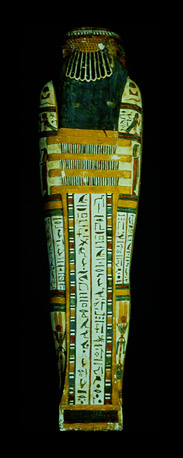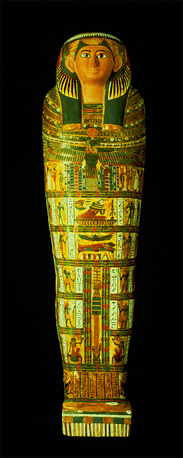Mummification
What is Mummification?

Mummification is the preservation of a body, either animal or human. Some mummies are preserved wet, some are frozen, and some are dried. It can be a natural process or it may be deliberately achieved. The Egyptian mummies were deliberately made by drying the body. By eliminating moisture, you have eliminated the source of decay. They dried the body by using a salt mixture called natron. Natron is a natural substance that is found in abundance along the Nile river. Natron is made up of four salts: sodium carbonate, sodium bicarbonate, sodium chloride, and sodium sulfate. The sodium carbonate works as a drying agent, drawing the water out of the body. At the same time the bicarbonate, when subjected to moisture, increases the pH that creates a hostile environment for bacteria. The Egyptian climate lent itself well to the mummification process, being both very hot and dry.
Why Did The Ancient Egyptian's Mummify Their Dead?

The Egyptians believed that there were six important aspects that made up a human being: the physical body, shadow, name, ka (spirit), ba (personality), and the akh (immortality). Each one of these elements played an important role in the well being of an individual. Each was necessary to achieve rebirth into the afterlife.
With the exception of the akh, all these elements join a person at birth. A person's shadow was always present. A person could not exist with out a shadow, nor the shadow without the person. The shadow was represented as a small human figure painted completely black.
A person's name was given to them at birth and would live for as long as that name was spoken. This is why efforts were made to protect the name. A cartouche (magical rope) was used to surround the name and protect it for eternity.
The ka was a person's double. It is what we would call a spirit or a soul. The ka was created at the same time as the physical body. The doubles were made on a potters wheel by the ram-headed god, Khnum. The ka existed in the physical world and resided in the tomb. It had the same needs that the person had in life, which was to eat, drink, etc. The Egyptians left offerings of food, drink, and worldly possessions in tombs for the ka to use.
The ba can best be described as someone's personality. Like a person's body, each ba was an individual. It entered a person's body with the breath of life and it left at the time of death. It moved freely between the underworld and the physical world. The ba had the ability to take on different forms.
The akh was the aspect of a person that would join the gods in the underworld being immortal and unchangeable. It was created after death by the use of funerary text and spells, designed to bring forth an akh. Once this was achieved that individual was assured of not "dying a second time" a death that would mean the end of one's existence.
An intact body was an integral part of a person's afterlife. Without a physical body there was no shadow, no name, no ka, ba, or akh. By mummification, the Egyptians believed they were assuring themselves a successful rebirth into the afterlife.
Egyptian Mummies
Thanks for [DarkJenni]for her help in preparing that wiki

back to
Ancient Egypt Lovers
 Stumble!
Stumble!

